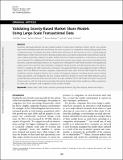Validating Gravity-Based Market Share Models Using Large-Scale Transactional Data
Author(s)
Suhara, Yoshihiko; Bahrami, Mohsen; Bozkaya, Burcin; Pentland, Alex Sandy’
DownloadPublished version (785.4Kb)
Publisher Policy
Publisher Policy
Article is made available in accordance with the publisher's policy and may be subject to US copyright law. Please refer to the publisher's site for terms of use.
Terms of use
Metadata
Show full item recordAbstract
Customer patronage behavior has been widely studied in market share modeling contexts, which is an essential step toward estimating retail sales and finding new store locations in a competitive setting. Existing studies have conducted surveys to estimate merchants' market share and factors of attractiveness to use in various proposed mathematical models. Recent trends in Big Data analysis allow us to better understand human behavior and decision making, potentially leading to location models with more realistic assumptions. In this article, we propose a novel approach for validating the Huff gravity market share model, using a large-scale transactional dataset that describes customer patronage behavior at a regional level. Although the Huff model has been well studied and widely used in the context of sales estimation, competitive facility location, and demand allocation, this article is the first in validating the Huff model with a real dataset. Our approach helps to easily apply the model in different regions and with different merchant categories. Experimental results show that the Huff model fits well when modeling customer shopping behavior for a number of shopping categories, including grocery stores, clothing stores, gas stations, and restaurants. We also conduct regression analysis to show that certain features such as gender diversity and marital status diversity lead to stronger validation of the Huff model. We believe we provide strong evidence, with the help of real-world data, that gravity-based market share models are viable assumptions for retail sales estimation and competitive facility location models.
Date issued
2021Department
Program in Media Arts and Sciences (Massachusetts Institute of Technology)Journal
Big Data
Publisher
Mary Ann Liebert Inc
Citation
Suhara, Yoshihiko, Bahrami, Mohsen, Bozkaya, Burcin and Pentland, Alex Sandy’. 2021. "Validating Gravity-Based Market Share Models Using Large-Scale Transactional Data." Big Data, 9 (3).
Version: Final published version